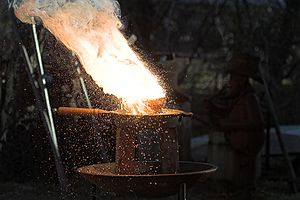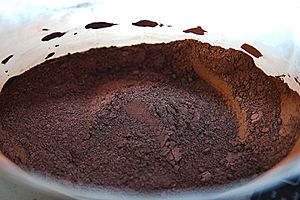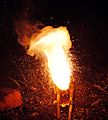Thermite facts for kids
Thermite is a special mix of chemicals that burns very, very hot. It's not an explosion, but it can burn super fast. Think of it like a super-hot fire that can even melt metal!
It's usually made from two different metal powders. One is a metal oxide (a metal combined with oxygen), and the other is a pure metal that is more "reactive." This means the pure metal likes to combine with oxygen more strongly than the metal in the oxide.
A common thermite mix uses iron(III) oxide (which is like rust) and aluminium powder. When this mix burns, the aluminium "steals" the oxygen from the iron oxide. This turns the iron oxide into pure iron, and the aluminium turns into aluminium oxide.
Many other metals and metal oxides can be used to make thermite. For example, you could use boron, magnesium, or zinc as the pure metal. And you could use copper(II) oxide or chromium(III) oxide as the metal oxide. The important rule is that the pure metal must be more reactive than the metal in the oxide for the reaction to work.
Contents
How Thermite Works and How to Start It
The chemical reaction for the common aluminium-iron(III) oxide thermite looks like this:
- 2 Al + Fe2O3 → Al2O3 + 2 Fe
This means two parts of aluminium react with one part of iron(III) oxide to make one part of aluminium oxide and two parts of iron.
It's actually quite hard to start a thermite reaction. It needs a lot of heat to get going! People often use special things to ignite it, like strips of magnesium metal. You can also use a mix of potassium permanganate and glycerin. Even a sparkler or a flint lighter can sometimes start it. Sometimes, sulfur is added to the mix to make it easier for the iron to melt once the reaction starts.
You might not think of metals as burning, but they can! For metals to burn easily, they usually need to be in a very fine powder. If they are in a big chunk, the heat spreads out too fast for them to catch fire.
The History of Thermite
The amazing thermite reaction was first found in 1893. A German chemist named Hans Goldschmidt got a patent for it in 1895. People sometimes called it the "Goldschmidt reaction" after him.
Goldschmidt was originally trying to make very pure metals without using carbon in a process called smelting. But he soon realized how useful thermite could be for welding things together. It started being used in the early 1900s to weld train tracks.
What is Thermite Used For?
Thermite is still used today for its original purpose: welding railroad rails. It's also used to weld wires.
Besides welding, thermite can also help make some pure metals. For example, chromium can be made using a thermite reaction between chromium(III) oxide and aluminium. The very first uranium was also made this way! Thermite can even be found in some fireworks to help other parts of the firework burn.
In the past, thermite was used by the military as a weapon to start fires. It's great for destroying buildings and equipment because it melts metal so easily. Sometimes, barium nitrate was added to thermite to make it burn even more easily. During World War II, armies dropped many bombs containing thermite on cities, which caused huge fires.
Safety First: Why Thermite is Dangerous
Thermite is not safe to make or use at home. It's extremely dangerous for several reasons:
- It gives off very strong ultraviolet light, which can seriously hurt your eyes.
- It creates a super-hot flame that can melt iron.
- Once it starts burning, it's incredibly hard to stop.
- Streams of molten (melted) iron can flow out of the burning mix, setting fire to anything they touch.
- Some metals, like zinc, can boil and burst into flames if they touch burning thermite.
- If thermite is heated up before it's lit, it can burn even faster and release a huge amount of heat and light very quickly.
- If thermite is dropped into water, it can make the water boil so fast that it causes an explosion! Dropping it on ice can also make the ice explode. However, it is safe to drop it into a large container of slightly wet sand.
Images for kids
See also
 In Spanish: Termita (mezcla reactante) para niños
In Spanish: Termita (mezcla reactante) para niños







